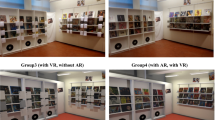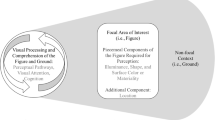Abstract
Metaphor is the underlying mechanism of information communication. Although metaphors are ubiquitous in information visualization designs, different connotations influence users’ information processing differently. Visual metaphors, however, may imply interfering attributes possibly caused by the source concepts, and lead to backfire effects on users’ inferences. Understanding the pros and cons of metaphoric transfer effect in information visualization would help optimize visualization designs, and improve efficiency and accuracy of information processing. This paper empirically examines how metaphors influence different activities of information processing, including comprehension, inference and judgment in information visualization. Metaphors illustrating clear semantic meanings in the source domain can improve both the user’s conceptual fluency in information comprehension, and the rate of correct information search.
Graphical Abstract









Similar content being viewed by others
References
Adams FM, Osgood CE (1973) A cross-cultural study of the affective meanings of color. J Cross Cult Psychol 4(2):135–156
Alter AL, Oppenheimer DM (2009) Uniting the tribes of fluency to form a metacognitive nation. Personal Soc Psychol Rev 13(3):219–235
Barr P, Khaled R, Noble J, Biddle R (2005) A taxonomic analysis of user-interface metaphors in the Microsoft office project gallery, Australasian User Interface Conference, (Newcastle, Australia, 2005, January/February), pp 109–117
Barthers R (1977) Image music text. Hill and Wang, New York
Belke B, Leder H, Strobach T (2010) Cognitive fluency: high-level processing dynamics in art appreciation. Pers Ubiquitous Comput 4(4):214–222
Borgo RK, Chung DHS, Maguire E, Laramee RS, Hauer H, Ward M, Chen M (2013) Glyph-based visualization: foundations, design guidelines, techniques and applications. In: The 34th Annual Conference of the European Association for Computer Graphics, Girona, Spain, 6–10 May 2013 doi: 10.2312/conf/EG2013/stars/039-063
Cai Z, Li YN, Zheng XS, Zhang K (2015) Applying feature integration theory to glyph-based information visualization. In: The 8th IEEE Pacific Visualization Symposium 2015, Hangzhou, China, 15–17 April 2015
Cantor N, Mischel W (1979) Prototypes in Person Perception. Advances experimental soc psychol 12:3–52
Card S, Mack R, Kellog W (1988) Interface metaphors and user interface design. In: Hellander M (ed) Handbook of human computer interaction. Elsevier Science Publisher, North Holland
Cayli M, Cobanoglu MC, Balcisoy S (2013) GlyphLink: an interactive visualization approach for semantic graphs. J Vis Lang Comput 24:463–471
Cybulski JL, Keller S, Saundage D (2014) Metaphors in interactive visual analytics. In: Proceedings of The 2014 Visual Information Communication International Symposium , (Sydney, Australia, 5–8 August, 2014), VINCI’14, ACM, pp 212–215
Ditto PH, Lopez DF (1992) Motivated skepticism: use of differential decision criteria for preferred and nonpreferred conclusions. J Pers Soc Psychol 63:568–584
Gombrich EH (1960) Art and illusion: a study in the psychology of pictorial representation. Princeton University Press, Princeton
Havre Susan, Hetzler Elizabeth, Whitney Paul, Nowell Lucy (2002) ThemeRiver: visualizing thematic changes in large document collections. IEEE Trans Visual Comput Graphics 8(1):9–20
Heukelman D, Obono SE (2009) Exploring the African Village Metaphor for computer user interface icons. In: proceedings of the 2009 annual research conference of the South African institute of computer scientists and information technologists, Vaal River, South Africa, October 13-14, SAICSIT ‘09, ACM, New York, pp 132–140. doi:10.1145/1632149.1632167
Howell M, Love S, Turner M (2005) Spatial metaphors for a speech-based mobile city guide service. Pers Ubiquitous Comput 9(1):32–45
Huff D (1954) How to lie with statistics. WW Norton and Company, New York
Indurkhya B (2007) Rationality and reasoning with metaphors. New Ideas Psychol 25:16–36
Johnson M (1987) The body in the mind: the bodily basis of meaning, imagination, and reason. University of Chicago Press, Chicago
Kelley CM, Lindsay DS (1993) Remembering mistaken for knowing: ease of retrieval as a basis for confidence in answers to general knowledge questions. J Mem Lang 32:1–24
Koriat A (1993) How do we know that we know? The accessibility model of the feeling of knowing. Psychol Rev 100:609–639
Lakoff G (1987) Women, fire, and dangerous things what categories reveal about the mind. University of Chicago Press, Chicago
Lakoff G (1992) The Contemporary Theory of Metaphor. In: Ortony Andrew (ed) Metaphor and though, 2nd edn. Cambridge University Press, Cambridge
Lakoff G, Johnsen M (2003) Metaphors we live by. The University of Chicago Press, London
Landau MJ, Meier BP, Keefer LA (2010) A metaphor-enriched social cognition. Psychol Bull 136(6):1045–1067
Lei ST, Zhang K (2011) Visual signatures for financial time series. In: Proceedings of the 2011 Visual Information Communication International Symposium. Article 16, (Hong Kong, China, 4–5 Aug, 2011), VINCI’11, ACM
Li Y-N, Li D-J, Zhang K (2015) Metaphoric transfer effect in information visualization using glyph. In: Proceedings of The 8th International Symposium on Visual Information Communication and Interaction, VINCI15, 24–26 August, Tokyo, Japan, ACM, pp 121–130
Lin S, Fortuna J, Kulkarni C, Stone M, Heer J (2013) Selecting semantically-resonant colors for data visualization, In: Proceedings of the 34th Annual Conference of the European Association for Computer Graphics. Girona, Spain, May 6–10, Eurographics Conference on Visualization (EuroVis), vol. 32, No. 3
Mamassian P (2008) Ambiguities and conventions in the perception of visual art. Vision Res 48(20):2143–2153
Miceli GN, Scopelliti I, Donato C (2014) Breaking through complexity: visual and conceptual dimensions in logo evaluation across exposures. Psychol Mark 31(10):886–899
Morris MW, Sheldon OJ, Ames DR, Young MJ (2007) Metaphors and the market: consequences and preconditions of agent and object metaphors in stock market commentary. Organ Behav Hum Decis Process 102:174–192
Nguyen QV, Zhang K, Simoff S (2015) Unlocking the complexity of port data with visualization. IEEE Trans Hum Mach Syst 45(2):272–279
Pandey AV, Manivannan A, Nov O, Satterthwaite ML, Bertini E (2013) The Persuasive Power of Data Visualization. IEEE Trans Visual Comput Graphics. doi:10.1109/TVCG.2014.2346419
Petty RE, Cacioppo JT (1986) Communication and persuasion: central and peripheral routes to attitude change. Springer-Verlag, New York
Raja F, Hawkey K, Hsu S, Wang KLC, Beznosov K (2011) A Brick Wall, a Locked Door, and a Bandit: a Physical Security Metaphor for Firewall Warnings, Symposium on Usable Privacy and Security (Pittsburgh, PA. July 20-22, 2011). SOUPS ‘11, ACM
Reber R, Schwarz N (1999) Effects of perceptual fluency on judgments of truth. Conscious Cogn 8:338–342
Ropinski T, Oeltze S, Preim B (2011) Survey of glyph-based visualization techniques for spatial multivariate medical data. Comput Graphics 35:392–401
Schwarz N, Sanna LJ, Skurnik I, Yoon C (2007) Metacognitive experiences and the intricacies of setting people straight: implications for debiasing and public information campaigns. Adv Exp Soc Psychol 39:127–161
Song H, Schwarz N (2010) If it’s easy to read, it’s easy to do, pretty, good, and true. The Psychologist 23(2):108–111
Winkielman P, Schwarz N, Fazendeiro T, Reber R (2003) The Hedonic Marking of Processing Fluency: Implications for Evaluative Judgment. In: Musch J, Klauer KC (eds) The psychology of evaluation: affective processes in cognition and emotion. Erlbaum Inc, Mahwah
Ziemkiewicz C, Kosara R (2008) The shaping of information by visual metaphors. IEEE Trans Visual Comput Graphics 14(6):1269–1276
Acknowledgments
This research is supported by National Nature Science Foundation of China (61572348), China Postdoctoral Science Foundation (2014M561178, 2014M551017) and International postdoctoral exchange fellowship (No. 20150046). The authors would like to thank Zhuang Cai for his generation of visualization images used in this paper.
Author information
Authors and Affiliations
Corresponding author
Rights and permissions
About this article
Cite this article
Li, YN., Li, DJ. & Zhang, K. The impact of metaphors on information visualization. J Vis 20, 487–504 (2017). https://doi.org/10.1007/s12650-016-0371-9
Received:
Revised:
Accepted:
Published:
Issue Date:
DOI: https://doi.org/10.1007/s12650-016-0371-9




